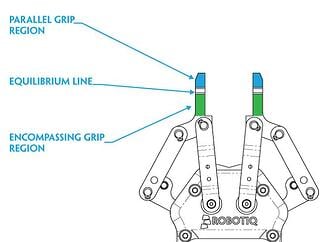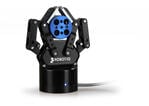How Do Fingers on the 2-Finger 85 Adaptive Gripper Work?

Posted on May 18, 2014 in Robot Grippers
2 min read time
When watching how the 2-Finger Adaptive Robot Gripper works in the following video you might ask yourself; how this Gripper can be so versatile while using only one actuator? The secret lies in its unique mechanical architecture.
Encompassing grasp region vs pinch grasp region


The mechanism driving the fingers of this Gripper is optimized to obtain two distinct contact regions. The first one, called the “encompassing grip region”, is located at the base of the fingers, while the second one, called the “pinch grip region”, is located at their end/tip. The boundary between these two adjacent regions is called the “equilibrium point”. When the contact of the finger with the object to be grasped occurs in the encompassing grip region, the finger automatically adapts to the shape of the object and curls around it. On the other hand, when the contact is made in the pinch grip region, the finger maintains its parallel motion and the object is pinched.
When the contact of the finger with the object to be grasped occurs in the encompassing grip region, the finger automatically adapts to the shape of the object and curls around it. On the other hand, when the contact is made in the pinch grip region, the finger maintains its parallel motion and the object is pinched.
Since the finger keeps its parallel motion when a contact is made above the equilibrium point during a pinch grip, the same is true for a contact made below the equilibrium point during an inside grip, i.e. for a force applied at the back of the finger. This unique feature allows the Gripper to pick up objects from the inside, which proves to be very useful in many situations.
Coupling between the fingers
In addition to the mechanism used inside each of its fingers, the Gripper also relies on a special coupling architecture between the fingers. In fact, it is mechanically designed to ensure that the two fingers move in conjunction with each other in order to center the object grasped in the middle of the Gripper. This self-centering avoids the need to use expensive sensors and is above all safer.
In the same vein to make this Robot Gripper as reliable as possible, a self-locking feature has been incorporated into it between the actuator and the fingers. By doing so, we are sure that the Gripper will never release the object and let it fall if the power is shut down. It is also economically interesting, as the actuator doesn’t need to apply torque continually when an object is grasped, thus in addition to the power saved, the lifespan of the Gripper is thereby maximized.
To learn more about the 2-Finger 85 Adaptive Gripper follow the link below or hit our website.


.jpg)





Leave a comment